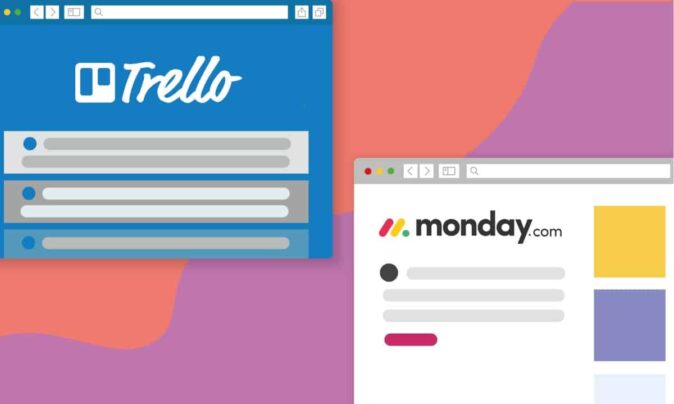Even when you tell yourself that “this time is going to be different,” project costs somehow manage to get out of control.
You’re not alone. Only 43% of projects are “mostly or always” completed on budget.
So what’s the solution? Let’s talk about project cost management. 💰
This guide will teach you about proper project cost management to help you create accurate project cost estimates, allocate money where needed, and monitor costs from start to finish.
What is project cost management?
Project cost management is the process of estimating, budgeting, controlling, and tracking expenditures throughout a project life cycle. This process allows a project manager better financial control over a project.
You can break down project cost management into three parts:
- Cost estimating: this includes estimating the cost of the project and determining contingency funds for emergencies and risks
- Cost budgeting: you allocate specific expenses and typically create a project budget that you’ll be tracking the project against
- Cost control: when the project starts, you need to monitor, control, and report the costs on an ongoing basis
Why is project cost management important?
According to a study by Forecast and Cactus, 91% of agency leaders think they could be doing better when it comes to generating profits from their client work.
The no.1 issue preventing agencies from increasing profits? Inefficient delivery processes.
Organizations that better manage the costs of their projects waste 28X less money, and they:
- Run more successful projects: more projects completed within the budget not only mean more money, but they also mean better, stronger client relationships.
- Keep costs from getting out of control: prevent or mitigate project delays, redimensioning, or cost overruns.
- Set clear expectations: completing projects that meet client expectations (or, dare we say it — go above expectations) builds higher levels of trust.
Control scope creep: tracking your costs against your budget is crucial in avoiding scope creep, which is the undoing of countless projects.
The 9-step cost management process
Let’s revisit the different components of effective project cost management.
- Cost estimating
- Cost budgeting
- Cost control
You can effectively manage each component above and protect project profits by following this 9-step cost management plan.
- Evaluate the project and client
- Carry out a project discovery
- Create a Work Breakdown Structure
- Estimate the cost of the project
- Create a baseline project budget
- Plan and manage resources
- Track project costs
- Control project requests
- Create project status reports
1. Evaluate the project and client
Effective cost management starts with client/project vetting during your sales and project intake process.
This means establishing a process in which you evaluate the fit of each project and client to ensure it aligns with your company goals.
A basic process may look like this.
- Determine your business goals
- Determine project alignment
- Determine high-level scope, timeline and budget needed
- Determine the priority of the project
- Determine the actual scope of the project
- Determine the cost and ROI of the project
- Determine the start date
- Confirm a complete understanding of the project
Learn more about creating a more robust project intake process here.
2. Carry out a project discovery
One thing worth doing in every project, big or small, is project discovery.
What is project discovery?
Discovery is a phase in project management that involves creating a shared understanding of what work should be done, project constraints, risks, audience needs, project features, and brand and technical requirements.
The project discovery helps you to understand the scope of the project better and anticipate the:
- Known knowns – you know what you know (or think you know)
- Known unknowns – you know what you don’t know
- Unknown knows – you don’t know what you know
- Unknowns unknowns – you don’t know what you don’t know
The primary purpose of the discovery phase is to fully understand the project’s requirements — allowing you to create a more accurate project cost estimate.
3. Create a Work Breakdown Structure
Use a Work Breakdown Structure (WBS) to break the project into manageable chunks once you understand the project scope.
What exactly is a WBS?
A Work Breakdown Structure can integrate scope, cost, and deliverables into a single tool. It “breaks down” the structure of a project into manageable deliverables, phases, and tasks.
It helps organize, visualize, and manage projects more efficiently. It can serve as a framework for detailed cost estimation and control — and act as the foundation for the project schedule.
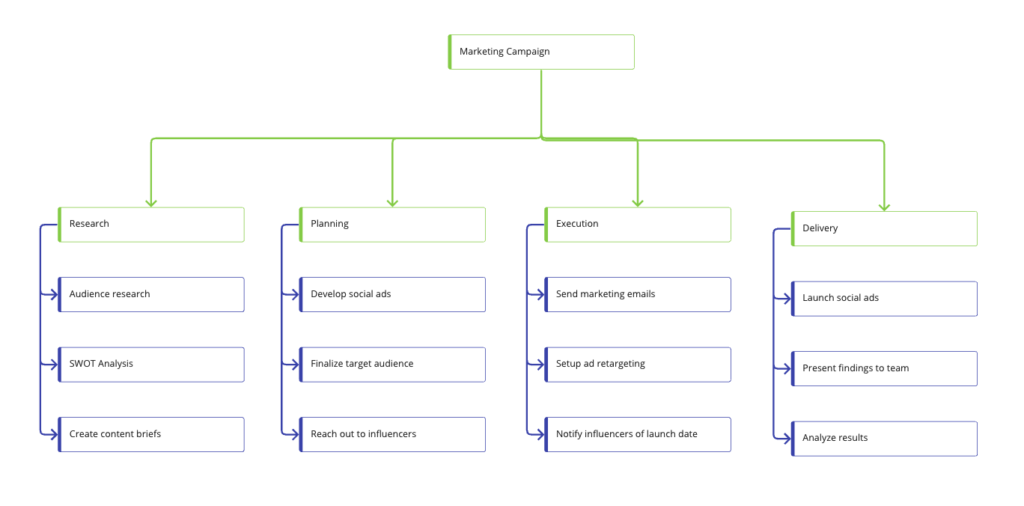
With a detailed WBS, you can:
- Visualize what tasks need to be completed to deliver the project successfully
- Visualize what kind of resources you need to complete the project on schedule
- Visualize how much each task will cost you in time and money
It’s a great way to visualize the project, nail down every critical, billable task, and spearhead resource planning.
4. Estimate the cost of the project
Start by estimating the time needed for each task, and ask your team to help you fill in the blanks.
We recommend the bottom-up project estimation technique, which involves estimating the costs at a task level to reach the overall estimate of the entire project.
This can be done using our WBS template in our Work Breakdown Structure Guide.

After the client’s reviewed your estimated budget, listen to their feedback and make adjustments until you reach a budget that everyone can agree on.
Don’t commit to creating a detailed budget from the off. We recommend starting with a ballpark estimate during your initial chats with a client. You can then create a budget or Statement o Work estimate once you know the client is interested in working with you.
Check out our guide on project cost estimating to learn more about the different types of estimates you can create.
5. Check if you have enough resources to complete the project
You’ll need to consider internal team capacity once you’ve estimated the cost and effort required for each task.
Your team probably has multiple projects on the go already, so you’ll need to ensure they have time to accommodate the incoming work.
Taking on projects without fully considering your internal team capacity will likely lead to project timelines being pushed back and the overall quality of the work taking a hit.
There are plenty of capacity planning tools out there. But if you’re using Toggl Plan, you quickly view your team’s capacity using Team Timelines.
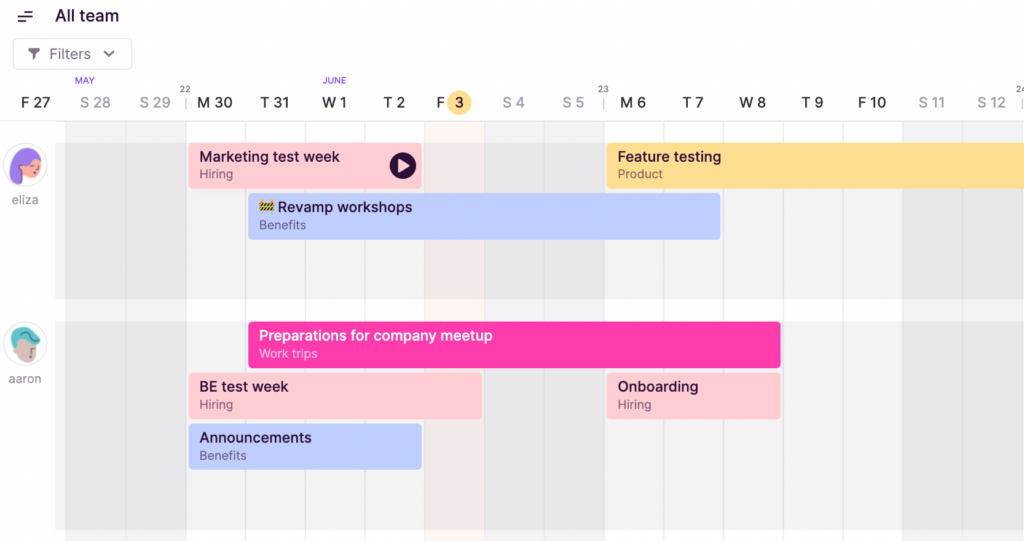
Team Timelines give you the best visual overview of who’s working on what and when.
That way, you can see at a glance what everyone is working on, make sure that no one is overloaded, and notice when there’s room for new projects.
Check out this page to learn more 👉 Resource Planning with Toggl Plan.
5. Create your baseline project budget and timeline
Use all the information you’ve collected above to create a baseline project timeline and project budget you and the client are happy with.
Once the client is happy with both, ensure you get them to sign a statement of work (SOW). This is the most crucial part of the entire project cost management process.
An SoW functions like a high-level project plan and should be included in your client contract.
At the minimum, an SoW describes your relationship with the client and what work you do for them. It helps teams manage and document expectations — and can save you a ton of pain later if things go pear-shaped…
“We thought that was included in the initial cost – why did you charge extra?” 😢
6. Add, schedule, and assign project tasks
Suppose your client is happy with your estimated budget and timeline, and you’ve signed your contracts. In that case, you can move forward with creating your project plan.
Project planning involves:
- Organizing the project tasks
- Allocating resources to each item
- Creating a project timeline
- Adding project milestones
It’s best to plot your project timeline and add milestones using project management software. Using Toggl Plan, you can easily add, schedule, and assign project tasks and milestones with simple drag-and-drop functionality.
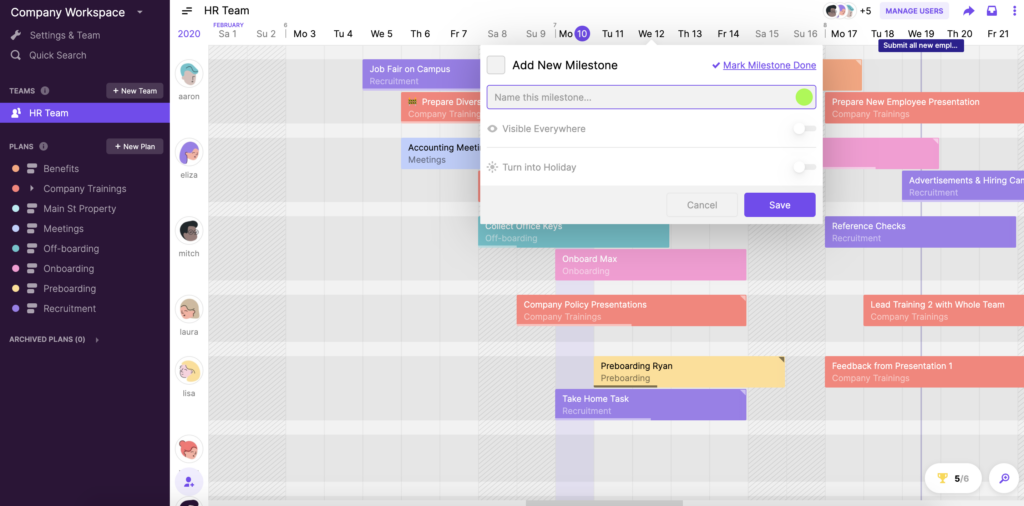
7. Track project costs
This is possibly the most crucial step: monitoring, tracking, and controlling your budget throughout the project lifecycle.
Now that the project’s in motion, it’s the project manager’s job to track project cost performance (estimates vs. actual costs). Taking the time to track and analyze ongoing costs enables you to take corrective action when necessary.
You have two options here.
Use a project budget template like the one below.

Or, use a time tracking tool to create, track and monitor project budgets. If you’re using Toggl Track, you can create a new project via the Projects tab and add the project tasks with their time estimates.
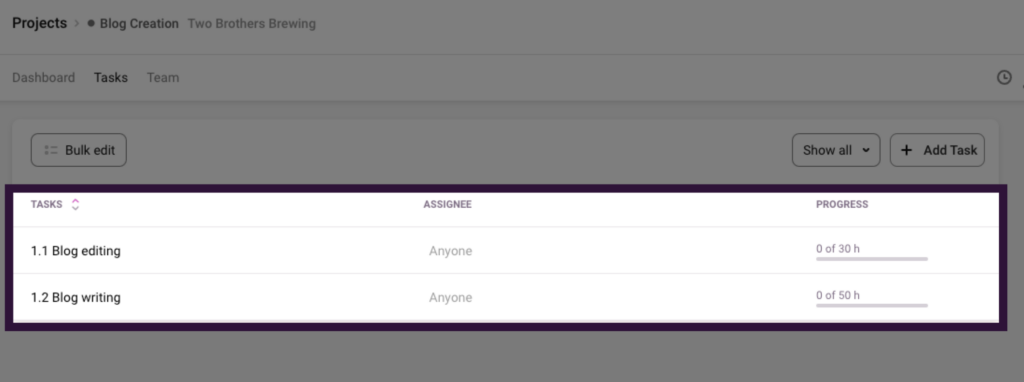
Once you or your team accurately tracks time against the tasks within a project, you can use the Project Dashboard to track your progress against the project budget.
The Time Tracking Chart will show a forecast for project completion based on the project estimate and the hours clocked for that project so far.

The Billing Amounts chart shows the progress against a fixed fee amount set for the project.
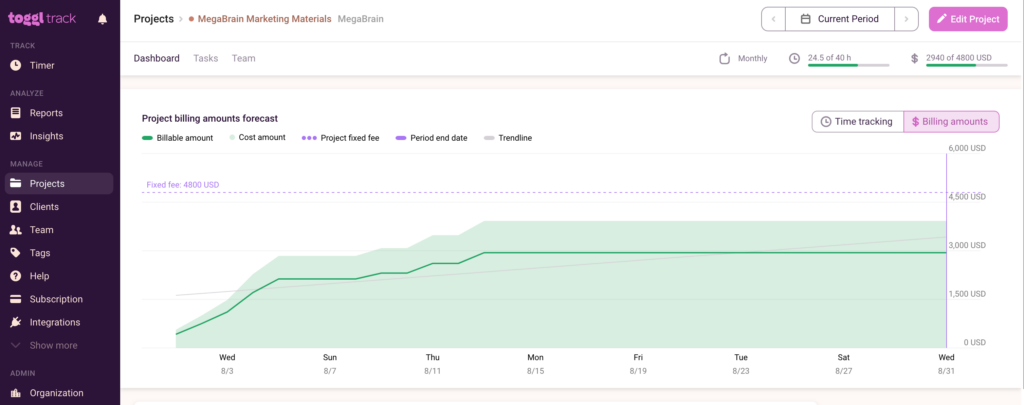
Below these forecasting charts, you will also see a bar and pie chart representing current data containing total clocked hours, billable hours, and remaining hours (based on the project estimate).

If you charge per hour for projects, you can track labor costs against project earnings inside of the Insights Dashboard.

Work with multiple contractors? Do employees have different labor rates? This can be set per project or team member within your workspace settings. Check out our ‘Billable rates‘ Knowledge Base article to learn more.
8. Control project requests
Another critical aspect of cost management is controlling changes throughout the project.
Even small changes can significantly impact the budget, so any additional requests from clients must be reviewed and approved.
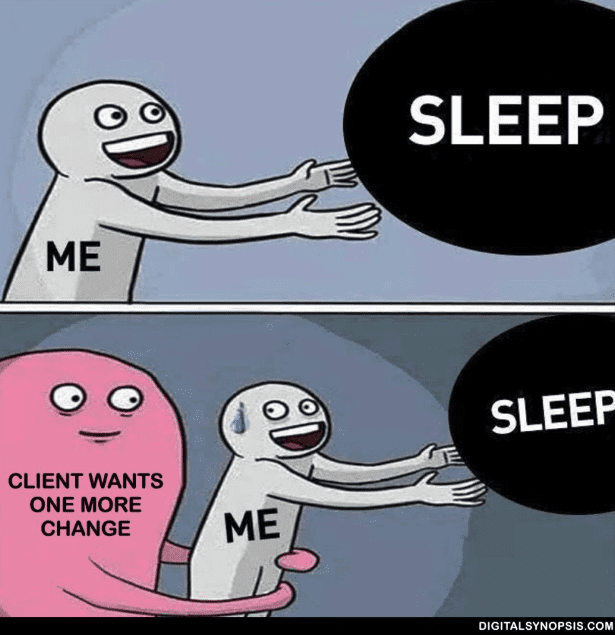
This is why getting the project scope signed off within an SoW by the client is critical for controlling and managing all project costs.
It’s best to get into the habit of documenting any items out of scope and tracking them over time if necessary.
This can be done by setting up a change control process with each client.
9. Create project status reports
Client projects have a tendency get to get a little out of control, and it can be challenging for project managers to keep on top of everything.

But that’s where project status reports can help.
What is a project status report?
Project status reports are timely updates on the progress of your projects. They are the best way to track, record, and review the performance and budget of a project.
They can be created at the end of each week or month or when you hit specific milestones or complete each phase within the project.
It’s entirely up to you.
But creating frequent project status reports will help you to catch issues that may derail your project.

Common challenges of managing project costs
Here’s a list of some of the most common challenges you may encounter and how to overcome them
1. Lack of budget to deliver the scope and quality required
2. Inaccurate estimations that lead to budget issues during the project
3. Scope creep and its effects on the budget
4. Outdated software and tech that make controlling the budget difficult
1. Lack of budget
It’s hard to spend money you had never allocated in the first place.
When a project doesn’t have the funds to be completed successfully, you likely ask the client for more money. This can be uncomfortable, and the alternatives aren’t fun either: going on without the money or swallowing the cost.
Lack of budget can be caused by the following:
- A new project manager with little experience in planning budgets
- Being overly optimistic and falling victim to the planning fallacy
- Poor project requirements gathering during project discovery
- A client who refused a larger budget (and you went ahead with the project anyway)
What can you do about it? Try to create more accurate project cost estimates.
Let’s explore how to do this in a little more detail. 👇
2. Inaccurate project estimations
Inaccurate estimations can drain your project profits and leave you without the cash to pay for resources and materials. This means you may not have the money to deliver the project to the client’s expectations.
A lot of little things can throw estimations off. Such as:
- Poor scoping of a project
- Skipping a project discovery phase
- Not considering the risks of the project
- Not using the right project estimation technique
How can you improve estimations?
- Chose the best cost estimation technique
- Use a Work Breakdown Structure (WBS) as part of the process
- Better scope out the project by collecting detailed project requirements
- Using historical data from similar past projects when estimating project costs
Check out the links above to learn more about how you get started with each tip.
3. Scope creep
Avoiding scope creep alone should be enough to make project managers want to double down on the project cost management process. After all, two leading causes of failed projects are a change in project objectives (37%) and inaccurate cost estimates (28%).
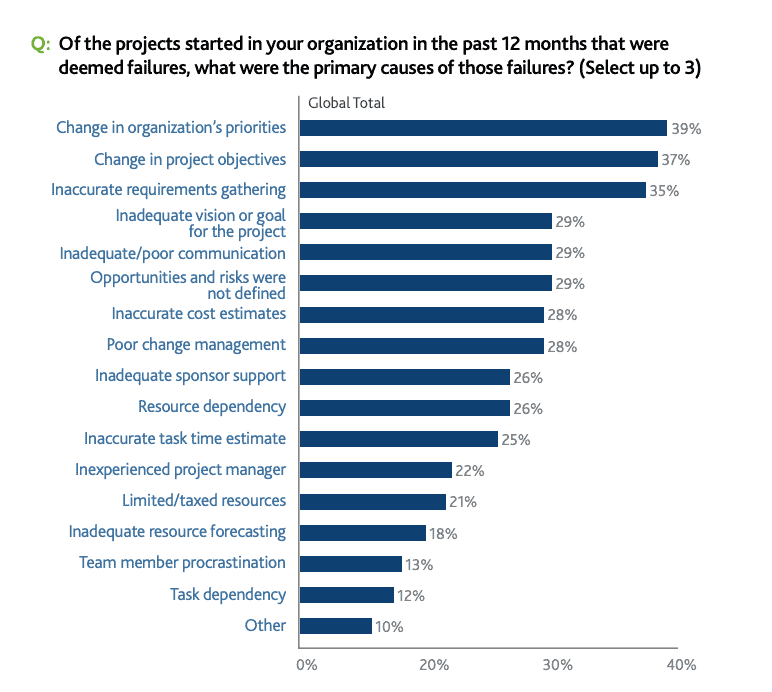
Project scope creep is an issue we all dread because it’s so common and so sneaky.
Scope creep generally happens client-side when extra requests come in that are out of scope while the project is in progress.
How do you best avoid scope creep? Check out the blog post below.
4. Outdated tools
Spreadsheets. The one project management tool to rule them all.
But are they the best tool to be managing project costs?
Probably not.
Tracking project costs can be done with a project budget spreadsheet.

But the issue with spreadsheets is that they become a headache as you begin to scale. Project budgeting software is one of the most crucial project management tools you can invest in.
Using Toggl Track, you can track project performance and assess project profitability in real-time.
You and your employees can quickly start tracking your time on projects by entering a time entry description and hitting the timer button.
It takes a few seconds to switch the timer to a different task (especially if projects and tasks are already set up).
- Type in your “time entry description”
- Find your client
- Select what “project” you’re working on
- Start the timer
As pointed out earlier in this guide, once you or your team accurately tracks time against the project, you can use the Project Dashboard to track your progress against the project budget.

Project cost management keeps a stellar project on course
We hate seeing outstanding projects run into problems because of poorly managed costs.
The biggest problems stem from a project already in progress — so we can’t stress tracking and controlling enough.
Cost control in project management lets you catch a snowball before it becomes an unstoppable “snow boulder.” ☃️
Check out the articles below for tips on protecting your future projects:
- How to Create and Manage a Project Budget
- Work Breakdown Structure Guide
- How to Estimate the Cost of a Project
Sean is a Content Marketer at Toggl. He's been involved in SEO and Content Marketing since 2017. Before working for Toggl, Sean ran SEO at a digital marketing agency—so he's all too familiar with time tracking and project management.




